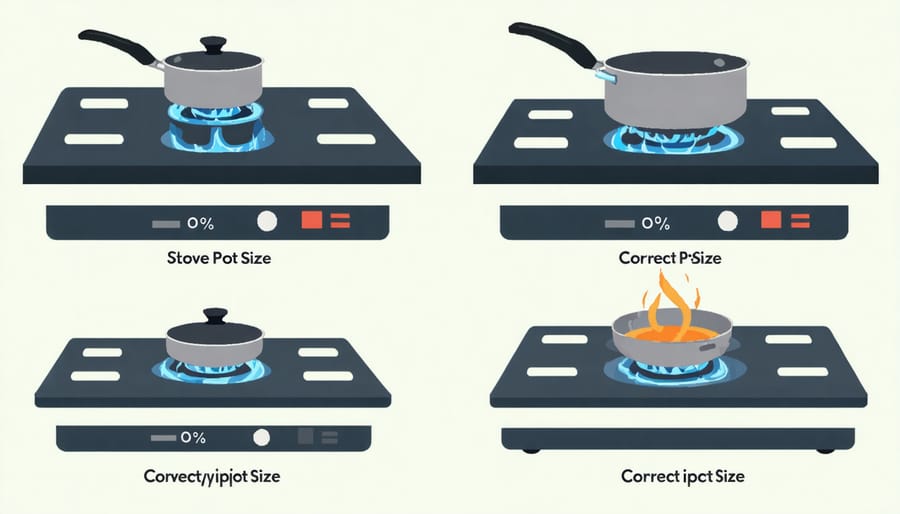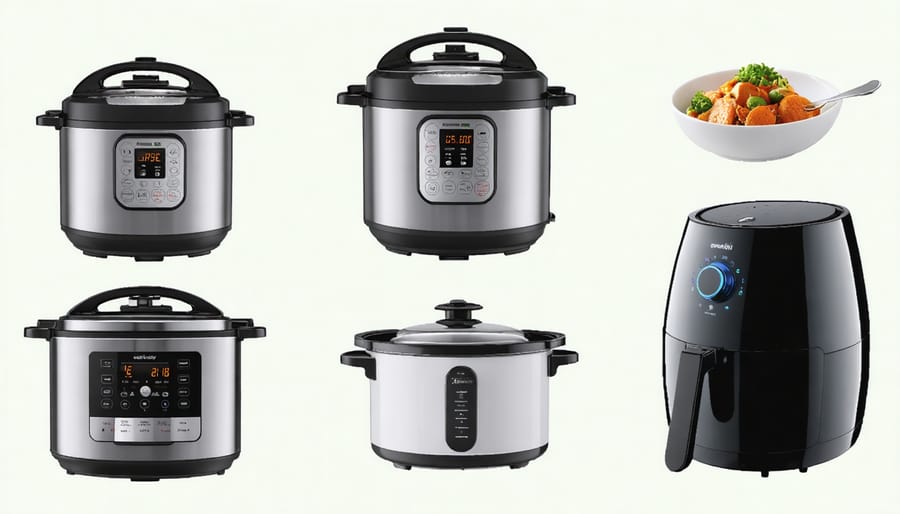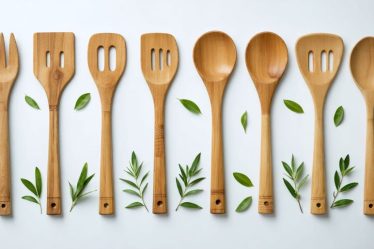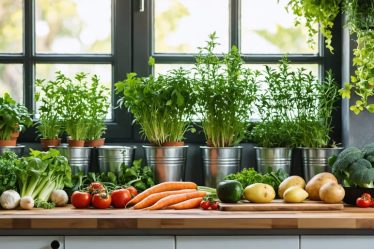
Transform your kitchen into an energy-saving powerhouse by mastering the art of efficient cooking. Every simmering pot and preheated oven presents an opportunity to slash energy bills while creating delicious meals for your family. Smart cooks know that efficiency isn’t just about rushing through recipes – it’s about thoughtful preparation, strategic cooking methods, and making the most of every BTU of energy.
Picture this: you’re preparing dinner while simultaneously reducing your carbon footprint and saving money. That’s the beauty of efficient cooking techniques. From choosing the right burner size for your pots to mastering the art of batch cooking, these methods aren’t just eco-friendly – they’re game-changers for busy households.
Whether you’re a seasoned home chef or just starting your culinary journey, efficient cooking practices can revolutionize your kitchen routine. They’re not about compromising on flavor or creativity; they’re about cooking smarter, not harder. Let’s explore how simple adjustments to your cooking habits can lead to significant energy savings while ensuring your meals remain just as delicious and satisfying as ever.
The real magic happens when efficiency meets everyday cooking – where practical tips transform into lasting habits that benefit both your wallet and the planet.
Kitchen Setup for Maximum Energy Savings
Smart Appliance Placement
Let me share a game-changing discovery from my kitchen renovation journey: smart appliance placement can revolutionize your cooking efficiency. Think of your kitchen as a well-choreographed dance floor where every step counts.
Start by positioning your refrigerator away from heat-producing appliances like your oven or dishwasher. When these appliances are too close, your fridge works harder to stay cool, driving up energy costs. I learned this the hard way when my energy bill shot up after placing my new fridge next to the oven!
Create an efficient workflow triangle between your sink, stove, and refrigerator. Ideally, these should be within 4-9 feet of each other, minimizing the distance you need to walk while cooking. Position frequently used small appliances, like your microwave or coffee maker, at counter height to avoid unnecessary reaching or bending.
Consider the natural light in your kitchen too. Placing energy-hungry appliances away from sunny windows helps them work more efficiently. And here’s a tip that transformed my cooking routine: dedicate a specific counter space for food prep between your refrigerator and stove. This simple adjustment can save countless steps and reduce the time your refrigerator door stays open.
Remember, even small changes in appliance placement can lead to significant energy savings and make your cooking experience more enjoyable.

Essential Energy-Saving Tools
As someone who’s been on a journey to make my kitchen more energy-efficient, I’ve discovered that having the right tools can make a world of difference. While there are countless smart kitchen gadgets available today, let’s focus on the essentials that truly help reduce energy consumption.
A quality pressure cooker tops my list – it’s a game-changer that cuts cooking time by up to 70% while preserving nutrients. I particularly love using mine for beans and tough cuts of meat. Next up is a properly-sized induction-compatible cookware set. These pans heat up quickly and distribute heat evenly, meaning less energy waste.
An electric kettle is another must-have. It uses significantly less energy than boiling water on the stovetop, and I use mine multiple times daily. Don’t forget about simple but effective tools like well-fitting pot lids (they reduce cooking time by trapping heat) and a food thermometer (prevents overcooking).
My personal favorite is a high-quality thermal cooker – think of it as a modern twist on the traditional slow cooker. It uses residual heat to continue cooking after just a short time on the stovetop, perfect for those busy days when you want a warm meal waiting for you.
Remember, these tools are investments that pay for themselves through energy savings over time. Start with one or two that match your cooking style and gradually build your collection.
Cooking Techniques That Save Power
Size-Matching Magic
Have you ever noticed how a tiny pan on a large burner feels somehow… wrong? Trust me, I learned this lesson the hard way when I first started cooking! Matching your cookware size to your burner size isn’t just about avoiding that awkward look – it’s actually a game-changer for energy-efficient cooking.
Think of it this way: when you use a small pan on a large burner, all that extra heat escaping around the edges is literally money and energy going up in smoke. I discovered that simply using the right-sized pot or pan can save up to 40% of the energy typically used for cooking. Pretty impressive, right?
For best results, your pot or pan should match or be slightly larger than the burner’s diameter. This ensures maximum heat transfer and minimal energy waste. Got a 6-inch burner? Reach for that 6-8 inch pan. Working with a larger 8-inch burner? Time to pull out your bigger cookware.
Here’s a clever tip I picked up from my grandmother: organize your pots and pans near your stove based on burner size. I’ve arranged mine in three groups – small, medium, and large – making it super easy to grab the right size without thinking twice. Not only does this save energy, but it also helps cook food more evenly and reduces the risk of burnt handles from overlapping onto other burners.

Batch Cooking Benefits
Remember those Sunday afternoons at my grandmother’s house, where the kitchen was a bustling hub of activity? She was the queen of batch cooking, and now I understand why. Batch cooking isn’t just about saving time; it’s a smart way to maximize your energy usage while creating delicious meals for days to come.
When you’re using your oven or stovetop, making the most of that energy means cooking multiple items at once. Think about roasting a chicken while simultaneously baking potatoes and vegetables on different racks. The same goes for your stovetop – while you’re simmering a pot of soup, you can steam vegetables or cook grains on another burner.
Planning is key to successful batch cooking. Before firing up your appliances, gather all your ingredients and prep everything you’ll need. Group foods with similar cooking temperatures and times together. For instance, while making lasagna, you could also bake a casserole for later in the week or prep a batch of granola.
The beauty of batch cooking lies in its versatility. Those roasted vegetables you made? They can become side dishes, salad toppers, or ingredients for quick stir-fries throughout the week. That big pot of marinara sauce? Perfect for pasta nights, homemade pizza, or as a base for other dishes.
Remember to invest in good quality storage containers and learn proper storage techniques to keep your batch-cooked meals fresh and delicious.
Residual Heat Cooking
One of my favorite kitchen secrets is letting residual heat do the heavy lifting in cooking. Think of it as nature’s slow cooker – that lingering warmth that continues cooking your food even after you’ve turned off the stove. I learned this trick from my grandmother, who always made the most incredible rice by letting it steam in its own heat.
Here’s how to make the most of residual heat: When cooking pasta, bring it to a boil, cook for about half the recommended time, then turn off the heat, cover the pot, and let it finish cooking in the hot water. The same principle works beautifully for hard-boiled eggs – bring them to a boil, cover, remove from heat, and let them sit for 10-12 minutes for perfect results.
This technique works especially well with foods like quinoa, couscous, and vegetables. For example, when steaming broccoli, turn off the heat just before it reaches your desired tenderness and let it finish cooking with the lid on. Not only does this method save energy, but it also prevents overcooking and helps retain more nutrients in your food.
Your stovetop and oven retain significant heat after use, so why not put that energy to work? When baking, turn off the oven a few minutes before the recipe suggests and let your dish finish cooking in the residual heat. Just remember to keep the oven door closed to trap the warmth inside.
Time-Saving Energy Hacks
Smart Meal Planning
Let me share a game-changer that revolutionized my kitchen routine: smart meal planning. By implementing effective meal prep strategies, you can significantly reduce your energy consumption while creating delicious meals for your family.
Start by planning meals that share cooking methods and temperatures. For instance, if you’re using the oven for Sunday’s roast chicken, maximize that heat by simultaneously baking a casserole for Monday and roasting vegetables for Tuesday’s dinner. This approach isn’t just about saving energy – it’s about making your life easier!
I’ve found that grouping similar cooking methods throughout the week works wonders. Try designating specific days for different cooking techniques: perhaps stovetop meals on Mondays and Wednesdays, oven-based dishes on Tuesdays and Thursdays, and no-cook meals on Fridays. This strategy helps you maintain consistent energy usage and prevents the constant heating and cooling of appliances.
Consider batch cooking when your appliances are already hot. While making tonight’s rice, cook extra for tomorrow’s stir-fry. When the oven’s warm for baking bread, pop in some sweet potatoes for later use. These small adjustments add up to significant energy savings without compromising on meal variety or quality.
Remember, smart planning isn’t about rigid schedules – it’s about finding a rhythm that works for your lifestyle while being mindful of energy use.
One-Pot Wonder Meals
There’s something magical about watching a complete meal come together in a single pot. As a busy mom who’s always juggling multiple responsibilities, I’ve found one-pot cooking to be a game-changer for both energy efficiency and time management.
Let’s start with my favorite: the classic Dutch oven chicken and vegetables. Simply layer root vegetables at the bottom, place a well-seasoned chicken on top, and let the oven do its work. The beauty lies in how the flavors meld together while using minimal energy. Plus, there’s only one pot to clean!
For vegetarian options, try a hearty Mediterranean quinoa dish. Combine quinoa, chickpeas, cherry tomatoes, and spinach in your pot, add vegetable broth and seasonings, and let it simmer. In just 20 minutes, you’ll have a nutritious meal that required minimal energy and attention.
The slow cooker is another energy-efficient hero. Prep your ingredients in the morning, set it on low, and return to a perfectly cooked stew or curry. Not only does it use less electricity than your oven, but it also transforms tougher (and often cheaper) cuts of meat into tender delights.
Remember to match your pot size to your portion needs – using an oversized pot wastes energy. And don’t forget to keep the lid on while cooking; every time you peek, you’re letting precious heat escape.

Alternative Cooking Methods
Let me share a game-changing discovery from my own kitchen journey: alternative cooking methods aren’t just time-savers – they’re true energy champions! My trusty pressure cooker has revolutionized how I prepare hearty stews and tender meats, cutting cooking time by up to 70% while using significantly less energy than traditional stovetop methods.
Slow cookers are another fantastic option for the energy-conscious cook. While they operate for longer periods, they use minimal electricity – about the same as a standard light bulb. I love tossing ingredients into my slow cooker before work and coming home to a perfectly cooked meal that cost mere pennies in energy to prepare.
Multi-cookers have become increasingly popular, combining the benefits of pressure cooking and slow cooking in one appliance. These versatile devices often include additional functions like steaming and yogurt-making, making them excellent investments for the efficient kitchen.
For smaller meals, consider using an air fryer or microwave. Air fryers use rapid air circulation to achieve crispy results with minimal energy, while microwaves remain one of the most energy-efficient ways to heat individual portions. I’ve found that steaming vegetables in the microwave not only preserves nutrients but also uses a fraction of the energy compared to stovetop steaming.
Remember, matching your cooking method to your meal size is key to maximizing efficiency. There’s no need to heat a large oven for a small dish when a more energy-efficient alternative is available.
As we wrap up our journey through efficient cooking techniques, I hope you’re feeling inspired to transform your kitchen into a more energy-smart space. Remember, small changes can lead to significant results – whether it’s choosing the right pot size, mastering the art of batch cooking, or making the most of your oven’s residual heat.
I’ve seen firsthand how implementing these methods not only reduces energy bills but also makes cooking more enjoyable and less time-consuming. One of my favorite discoveries was learning to use my pressure cooker for weekly meal prep – it’s amazing how much time and energy you can save with just one simple change!
The beauty of efficient cooking lies in its accessibility – you don’t need expensive equipment or professional training to get started. Begin with what you have, perhaps by trying batch cooking this weekend or experimenting with one-pot meals. As you become more comfortable with these techniques, you’ll naturally develop your own energy-saving strategies that work for your lifestyle.
Remember, efficient cooking is about more than just saving energy – it’s about creating a sustainable kitchen routine that serves you and your family better. Start small, be patient with yourself, and celebrate the positive changes you make along the way. Your future self (and your utility bills!) will thank you for taking these steps toward smarter, more efficient cooking habits.
Here’s to creating delicious meals while being mindful of our energy use. Happy cooking!



